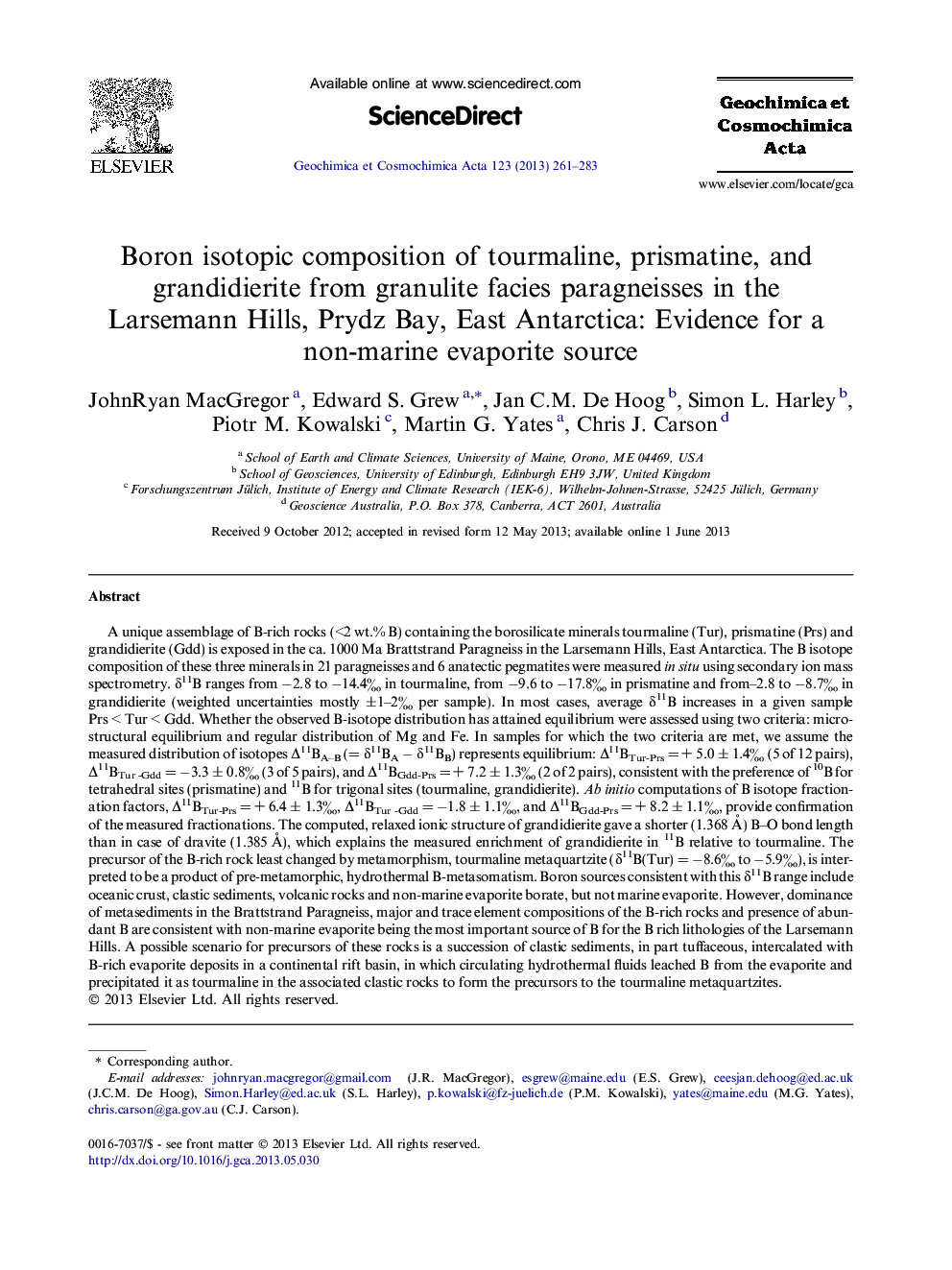| Article ID | Journal | Published Year | Pages | File Type |
|---|---|---|---|---|
| 6439093 | Geochimica et Cosmochimica Acta | 2013 | 23 Pages |
Abstract
A unique assemblage of B-rich rocks (<2 wt.% B) containing the borosilicate minerals tourmaline (Tur), prismatine (Prs) and grandidierite (Gdd) is exposed in the ca. 1000 Ma Brattstrand Paragneiss in the Larsemann Hills, East Antarctica. The B isotope composition of these three minerals in 21 paragneisses and 6 anatectic pegmatites were measured in situ using secondary ion mass spectrometry. δ11B ranges from â2.8 to â14.4â° in tourmaline, from â9.6 to â17.8â° in prismatine and from-2.8 to â8.7â° in grandidierite (weighted uncertainties mostly ±1-2â° per sample). In most cases, average δ11B increases in a given sample Prs < Tur < Gdd. Whether the observed B-isotope distribution has attained equilibrium were assessed using two criteria: microstructural equilibrium and regular distribution of Mg and Fe. In samples for which the two criteria are met, we assume the measured distribution of isotopes Î11BA-B (= δ11BA â δ11BB) represents equilibrium: Î11BTur-Prs = + 5.0 ± 1.4â° (5 of 12 pairs), Î11BTur -Gdd = â3.3 ± 0.8â° (3 of 5 pairs), and Î11BGdd-Prs = + 7.2 ± 1.3â° (2 of 2 pairs), consistent with the preference of 10B for tetrahedral sites (prismatine) and 11B for trigonal sites (tourmaline, grandidierite). Ab initio computations of B isotope fractionation factors, Î11BTur-Prs = + 6.4 ± 1.3â°, Î11BTur -Gdd = â1.8 ± 1.1â°, and Î11BGdd-Prs = + 8.2 ± 1.1â°, provide confirmation of the measured fractionations. The computed, relaxed ionic structure of grandidierite gave a shorter (1.368 Ã
) B-O bond length than in case of dravite (1.385Â Ã
), which explains the measured enrichment of grandidierite in 11B relative to tourmaline. The precursor of the B-rich rock least changed by metamorphism, tourmaline metaquartzite (δ11B(Tur) = â8.6â° to â5.9â°), is interpreted to be a product of pre-metamorphic, hydrothermal B-metasomatism. Boron sources consistent with this δ11B range include oceanic crust, clastic sediments, volcanic rocks and non-marine evaporite borate, but not marine evaporite. However, dominance of metasediments in the Brattstrand Paragneiss, major and trace element compositions of the B-rich rocks and presence of abundant B are consistent with non-marine evaporite being the most important source of B for the B rich lithologies of the Larsemann Hills. A possible scenario for precursors of these rocks is a succession of clastic sediments, in part tuffaceous, intercalated with B-rich evaporite deposits in a continental rift basin, in which circulating hydrothermal fluids leached B from the evaporite and precipitated it as tourmaline in the associated clastic rocks to form the precursors to the tourmaline metaquartzites.
Related Topics
Physical Sciences and Engineering
Earth and Planetary Sciences
Geochemistry and Petrology
Authors
JohnRyan MacGregor, Edward S. Grew, Jan C.M. De Hoog, Simon L. Harley, Piotr M. Kowalski, Martin G. Yates, Chris J. Carson,
